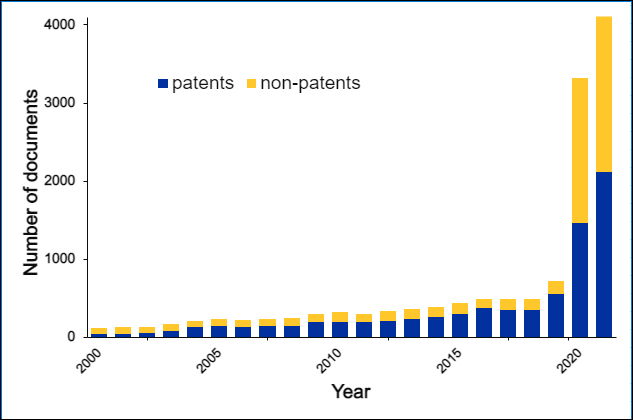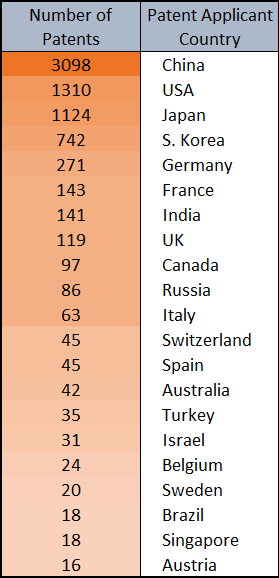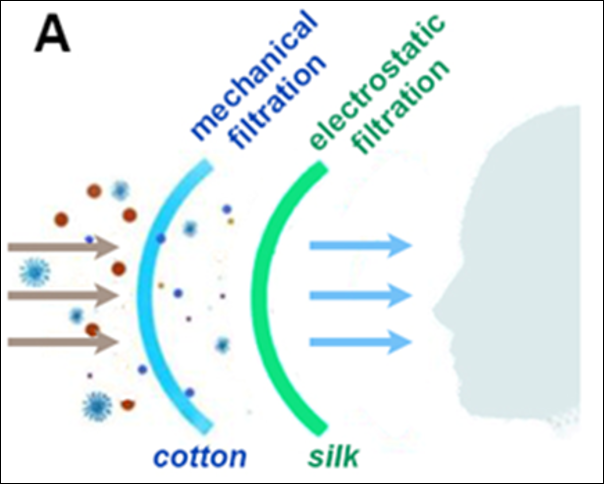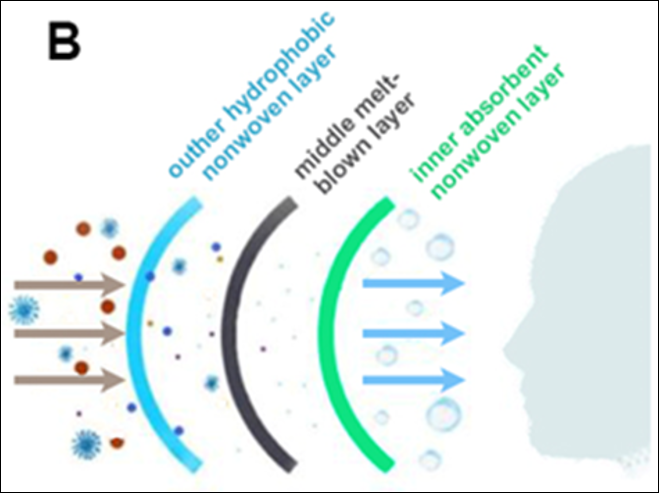Gain new perspectives for faster progress directly to your inbox.

Masks and personal protection equipment (PPE) have been a divisive topic but are proven to be effective at slowing the spread. Now, with the surge in Omicron BA.5 and BA.2.75 variant infections growing exponentially, improving mask technology will be critical. The COVID pandemic revealed deficiencies in the mask development and production process. However, the innovation of masks will be crucial in slowing the spread of new variants of the virus.
There are many factors that can be improved for masks, but this article focuses on the emerging science of improving filtration and microorganism removal.
Rapid Growth in IP and Research
The CAS Content Collection™ shows that worldwide scholars are focusing on how to make face covers more effective. Over 17,000 documents have been published on face masks, with more than half being from the last two years (Figure 1). Noteworthy is the distinct surge in patent applications, with China, the U.S., and Japan being the leading countries (Table 1).

Table 1. Distribution of patents related to face masks development among top applicants’ countries

What Are Masks Stopping?
Respiratory droplets are key transmission vehicles for spreading SARS-CoV-2, and those smaller than <5μm are generally categorized as aerosols. Direct exhalation of aerosol particles and droplets from infected patients is the predominant mode of transmission of SARS-CoV-2. Aerosols remain suspended in the air and play a key role in spreading infection. This underscores the importance of limiting aerosol spread, so face masks have been identified as an important tool in pandemic control.
How Masks Work Today
The minimal face mask can include just two layers of household fabrics and is still more effective than not one altogether. Filtration efficiency for particles < 300nm and >300nm can be improved by using different fabrics. This is from the synergistic effect of mechanical filtration from cotton and electrostatic filtration from the other layer comprised of materials like silk (Figure 2A).

The most used three-layer surgical mask in the COVID-19 pandemic is made up of three layers of nonwoven fabrics (Figure 2B). The three layers of a face mask work together to protect the wearer from harmful airborne particles. The outer layer is waterproof, the middle layer filters out pathogens, and the inner layer traps respiratory droplets. Nonwoven fabrics are cheap and easy to manufacture, which makes them easily accessible to the public.

New Advancements to Improve Masks
New polymeric materials, certain polystyrenes, and polycarbonates have enabled improvements of masks in two areas:
1. Better filters: material development to reduce pore size to capture and filter off small particles and pathogens
2. Better microorganism removal: increased antimicrobial properties through the application of coatings and self-cleaning properties
Improving Filtration
The efficacy of air filter masks is driven by fiber diameter, membrane thickness, and air permeability. Today's particulate matter filters are made of polymer fibers or fiberglass, which trap particles of various sizes. Recently, new types of smaller membrane filters have been developed that have a larger surface area. These filters are more efficient at capturing particles and reducing air resistance.
Polymer Nanofibrous Membranes
Decreasing fiber diameter to nanoscale leads to enhanced surface area and improved particle removal. Electrospinning is used for fabricating nanofibrous membranes with good transparency, high efficiency, and low weight. Several types of electrospun nanofiber membranes have been created from different materials. These membranes have different surface properties and can be used for air filtration masks.
Electret Membranes
Due to larger attraction distances, the electrostatic air filters are more effective at trapping particles than the passive membranes. Three charging techniques: in situ charging, corona charging, and tribocharging can be used to fabricate electret membranes. Nanoparticles (such as polytetrafluoroethylene, silicon nitride, magnesium stearate, etc.) are usually employed as charge enhancers. Several hybrid electret filters have been developed via the in situ charging technology of electrospinning. For example, an electrospun polyethylene/polypropylene membrane containing magnesium stearate exhibited a surface potential of 4.78kV and high filtration efficiency of 98.94%.
A triboelectric nanogenerator has been invented for effective particulate removal by nanofibrous air filters. The triboelectric nanogenerator produces energy from mechanical movements such as human motion and is suitable for use in self-powered wearable devices.
A self-powered electrostatic adsorption face mask equipped with a triboelectric nanogenerator exhibited highly improved particle removal efficiency. This is another air filter made of multiple layers of nylon and polytetrafluoroethylene fabrics. It is also effective at removing particles from the mask.
Improving Microorganism Removal
While filters capture matter, microorganisms such as bacteria, viruses, and fungi adhere to the filter surface. Therefore, air filters with antimicrobial properties are needed. To date, a variety of antimicrobial agents have been examined to create biocidal properties. These agents include natural products, metal nanoparticles, metal-organic frameworks (MOFs), graphene, and more.
Certain natural extracts exhibit high antimicrobial activity due to the flavonoids they contain. Natural products like tea tree oils, olive extracts, grapefruit seed, and Sophora flavescens, have been sprayed on the surfaces of fibrous polymeric filters, providing good antimicrobial activity.
New Metallic Applications
Metal nanoparticles exhibit a broad spectrum of antibacterial activities. Their bactericidal action mechanism includes:
1. Electrostatic attraction of the positively charged nanoparticles by the negatively charged bacterial cell walls, leading to cell wall disruption and enhanced permeability.
2. Metal ions can damage cells by causing the production of reactive oxygen species (ROS), which leads to oxidative stress. This disrupts cell functions and eventually kills the cell.
Silver nanoparticles have antimicrobial properties, so they are often used to make masks more effective at preventing the spread of disease.
Copper and copper oxide both have potent biocidal properties and have been incorporated into textiles and other products with antimicrobial and antiviral properties. The main mechanism of action for copper nanoparticles is the production of ROS during oxidation.
Graphene and its derivatives have been widely explored due to them taking advantage of their large surface area to enhance antimicrobial activity. A recent study reported that graphene-coated surfaces can be used to increase surface temperature and deactivate microorganisms. Upon solar irradiation, rapid local heating is generated and >90% of airborne bacteria are rapidly killed. This way, self-sterilizing reusable graphene masks can be provided.
New Purification Methods
Photocatalytic oxidation air purification is a process that involves a light-activated catalyst reacting with organic pollutants to oxidize them. It degrades diverse air pollutants into non-toxic forms using solar or artificial light.
Masks including titanium oxide (TiO2) or zinc oxide (ZnO) nanoparticles have exhibited effective filtration. A mask made of polyester fabric coated with ZnO nanoparticles was found to reduce surface bacteria by 98%.
Multifunctional air filters, which simultaneously remove both particles and microorganisms have proven effective. Recently, an Ag/ZnO nanorod-wrapped PTFE nanofibrous membrane has been created with an outstanding antibacterial activity against Escherichia coli (E.coli).
Another air filter has been made of carbon nanotubes and silver nanoparticles, with the nanotubes filling the pores of the filter. Loading silver nanoparticles on the high surface area of carbon nanotubes enhances their antimicrobial efficiency.
Metal-Organic Framework Filters
Metal-organic frameworks (MOFs) are porous crystalline materials coordinated to multidentate organic ligands. They are excellent filters because of their high porosity and tunable pore size.
For example, the incorporation of zeolitic imidazolate framework-8 (ZIF-8) nanocrystals in electrospun polyimide membranes highly enhanced the filtration efficiency of the filters. MOF-based filters can be made on various substrates, such as plastic mesh or nonwoven fabric. These filters work well for particle removal.
Looking Ahead
Masks are an effective way to slow the spread of respiratory viruses like the Omicron BA.5 and BA.2.75 variants. The new technologies and advancements in mask filtration and microorganism removal will be critical to slow future spreads and variants.
Learn more about COVID-19 variants like BA.5 and how a more comprehensive approach with vaccines, therapies, and masks can help us achieve sustained immunity.



